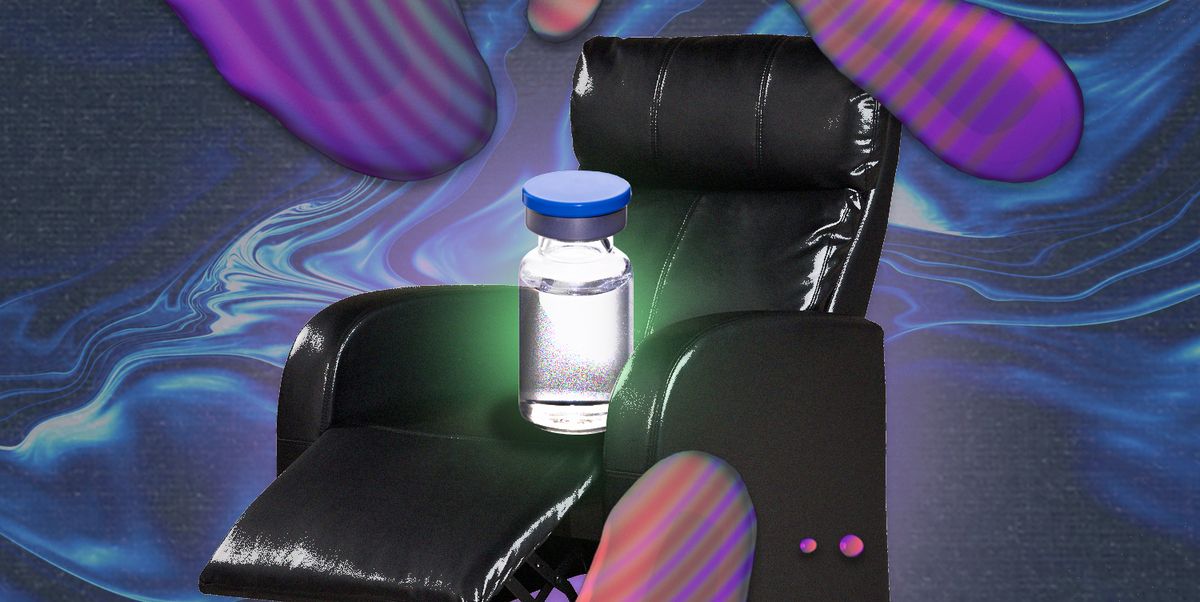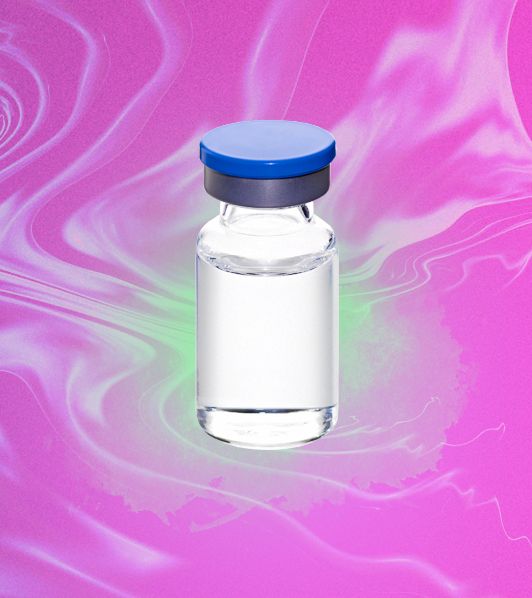Products You May Like
My Uber drops me off at 11:03 AM at a nondescript boxy and beige Manhattan Beach medical office park with anxiety pulsating throughout my body. Maybe it’s because my stomach is almost-empty with too much coffee, half a banana, and a spoon of peanut butter that per doctor’s orders, I consumed exactly 4 hours prior. But more likely, it’s that I’m about to get my mind blown with a therapeutic dose of ketamine straight to the veins. Before I know it, I’m reclining in a black leather La-Z-Boy, earbuds in, inspirational music cued up, with a blood pressure cuff on my right arm and an IV in my left. “It’s normal to be nervous, but just try to give into the process,” Jana, the nurse practitioner says. “Have a great trip,” I hear her voice fade away as I press play and pull my eye mask down. Minutes later, I’m simultaneously flying and melting on a rollercoaster that ushers me between scenes of The Nutcracker, Willy Wonka and the Chocolate Factory and woo-hoo, I’m hanging out in the Emerald City with the Wizard of Oz. I can’t feel my face, and with each deep breath into my belly, my body dissolves into nothingness. Pain and anxiety can’t exist here. I don’t ever want this feeling to stop.
“How’s my heart rate?” I ask, but don’t listen for the answer, just hoping with every bit of my being that this will end my suffering.
The last (and only) time I was on ketamine, I snorted it off some random dude’s thumb as a 21-year-old girl from Texas might do in an underground club in New York City. But today, the drug, a dissociative psychedelic- first synthesized in 1956, popular as an anesthetic in the 1970s and known by some as “Special K” and others as a horse tranquilizer –is being administered to me via IV over the span of 40-minutes. Why? Because it was recently touted as a “breakthrough” solution for the mental health crisis in the U.S.
Recent research has shown ketamine therapy to be a highly-effective and fast-acting solution for treatment-resistant depression (TRD), anxiety, PTSD, and suicidal ideations.
Yep, that’s me.
2022 had been a doozy- hands down the worst year of my 44-year existence. My second Covid vax kicked off a hormonal implosion, which spun into insomnia with rude middle-of-the-night awakenings and early morning cortisol surges that made my body scream. Thinking sleep was the issue, I took sedating meds, but one pill was more dysregulating than the next, rocking my nervous system into a frantically frayed state of complex PTSD. The hormone creams I enlisted to restore balance instigated left eye blindness, a strained relationship with my father, who had always been my rock, in addition to crazy alcoholic airbnb neighbors made me feel even more unsafe. The isolation of sleep deprivation and being new in town intensified it all, having me think, “how will I pull through this?” but more often, “which cliff should I drive off.”
In search of healing, I tried all the things- pharmaceuticals, talk therapy, outpatient trauma treatment, supportive living, EMDR, Brainspotting, TMS, Neurofeedback, and Somatic Experiencing. Oh, how could I forget hypnotherapy, acupuncture and bodywork? While some modalities effectively reduced triggers and calmed my nervous system, my progress eventually plateaued. I was better, but still laced with grief and despair, unable to see a way back to the woman I was before– someone who loved attending literary events, going on bike rides, and dancing on the beach.
So that’s how I ended up at the beige building blocks away from the Pacific Ocean, floating on candy-colored clouds and mainlining FDA-approved ketamine. I was on a mission to reclaim my wild and free.
There are two key elements working together in ketamine treatments. First, the medicine enters the brain’s prefrontal cortex and simply gets to work by fixing the parts that get broken when someone is depressed. Yes, the brain literally “breaks” from firing negative thoughts on repeat for so long. As someone who’s been muscling their way toward recovery, this was a huge bonus. I could lay back knowing that the ketamine was stimulating the regrowth of synapses (connections between neurons) and increasing neuroplasticity, (the ability of the brain to modify its connections), effectively rewiring my brain. #Winning
Dr. Todd Hill, DO, is the Medical Director of Neurowellness, a mental health treatment center in Los Angeles. “Ketamine works differently than antidepressants and other psychedelics by increasing levels of glutamate,” he says, naming the most abundant (and my new favorite) neurotransmitter. He explains that glutamate helps with emotion regulation, pain perception and plays a key role in cognitive function, especially learning and memory.
Then, there’s the psychedelic experience, or the “trip,” where you literally disassociate to get some breathing room from the thoughts, emotions, or events that are challenging your mental health. With this distance, one can witness patterns, identify solutions, and hopefully return to life with insights and fresh perspective. The processing that happens during a trip can surface intense emotions, both out-of-this-world joy, and deep sadness, but pro-ketamine advocates say it’s all part of the healing. If I spoke aloud during my trip, Jana captured my musings, which I would reflect on and integrate with my therapist.
Stephanie Seal, LCSW, is trained in KAP (Ketamine Assisted Psychotherapy) in Venice Beach.“Although it is possible to alleviate depression with just the pharmacologic effect of the drug, pre and post-integration work is what creates the fertile soil for more frequent breakthroughs and sustained improvement,” she says.
Because ketamine works on a systemic and psychological level to increase neuroplasticity, timing is everything. “There’s evidence that therapeutic integration sessions during the“golden hour” or 24-48 hours after dosing, really augment and extend the effectiveness of ketamine,” explains Seal.
Dr. Leonardo Vando is the Medical Director of Mindbloom, a new telemedicine company specializing in ketamine-based psychedelic therapy, who says he has seen many positive changes in his patients. “When shifts in how people see themselves is combined with a weakening of old maladaptive patterns of thinking and behaving, we have a supermolecule of change,” he says. “It is really a wonderful molecule that is helping thousands of patients live a better life.” Nine sessions in, I agree.
It was like someone flipped the switch on in my former brain—and it was on fire. Creative thoughts were flowing. Big ideas I used to have about who I wanted to be resurfaced. I rearranged my entire living room, cleaned out my closet, and bought light bulbs for the bedside table lamps that had been bulb-less for all of 2022. I was doing things that a non-depressed person does. The debilitating grief was mitigated so I could take steps forward. Most importantly, the suicidal ramblings ceased.
For the past few weeks, I’ve been more positive and creative, sleeping deeper, and rekindling connections in between singing the praises of my ketamine journey. But it’s not all sunshine and rainbows. These IVs aren’t cheap, a single treatment can range between $500-800, and there are risks including high blood pressure, vomiting, nausea, and disorientation. I sometimes find myself whispering to friends and family, “Just don’t let me get addicted, OK?” I’m slightly kidding, as my doctor says addictive potential is highly unlikely in a professionally monitored setting.
But I did wonder about the traditional western medicine perspective on ketamine- from someone who’s outside of the K-hole as a cure universe? Dr. Scott Braunstein of SollisHealth, a concierge medical service, believes that non-medicinal modalities (i.e. counseling, psychotherapy, exercise, meditation) and traditional anti-depressant medications should be first line of defense for mental health treatment. “If all these efforts have failed,” Dr. Braunstein tells me, “and their mental health issues are still debilitating, then I would be comfortable recommending a trial of ketamine therapy.” I felt assured knowing that I had exhausted the conventional avenues vs. diving into a K-hole straight away.
It’s also worth noting that not everyone is responsive to treatment. And although K-clinics are popping up all over the country, experts say there’s still more research needed to fully understand the drug and what a successful treatment protocol looks like. What is known is that there is a cumulative effect and four to six dosing sessions are recommended to see a significant shift in mood.
But at this moment, I’m less concerned with where the research shakes out and just grateful to feel alive again. I can see my wild and free in the distance and will chase it until we’re one again.
Aubree Nichols is a Los Angeles-based freelance writer whose work has appeared in The New York Times, Vogue, and LA Magazine.

